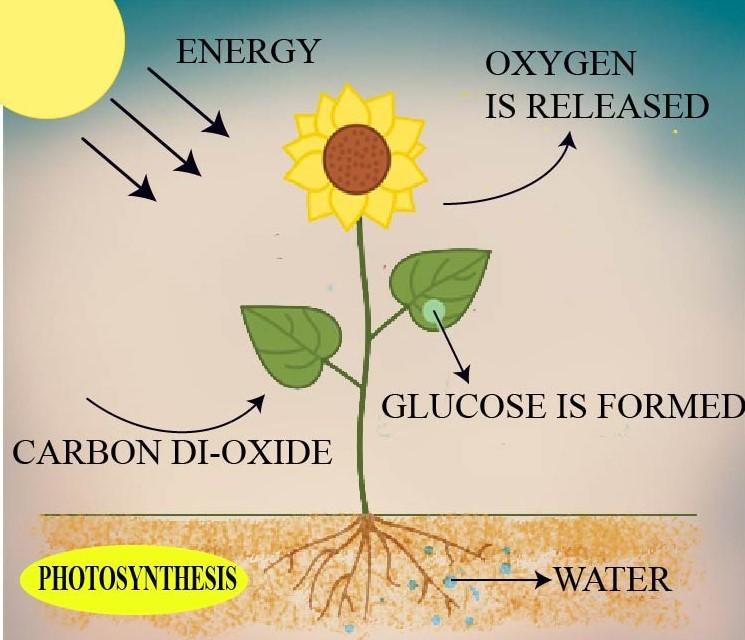
The autotrophic mode of nutrition requires
(a)Carbon dioxide
(b)Chlorophyll
(c)Sunlight
(d)All of the above
Answer
494.1k+ views
Hint:The autotrophic mode of nutrition refers to the formation of one's own food with the help of inorganic sources of energy. The plants contain membrane-bound organelles known as chloroplasts. They consist of a stack of membranous cells called grana. Each cell of a granum is called a thylakoid that contains the chlorophyll molecules.
Complete answer:
Photosynthesis is the natural process of conversion of solar energy into chemical energy. It results in the formation of organic compounds like carbohydrates. Plants synthesize their own food with the help of carbon dioxide, chlorophyll, water, and sunlight.
$6{ CO }_{ 2 }+6{ H }_{ 2 }O\xrightarrow { Sunlight\quad Energy } { C }_{ 6 }{ H }_{ 12 }{ O }_{ 6 }+6{ O }_{ 2 }$
-It is mainly responsible for the formation of oxygen that sustains all life forms on the earth.
-Different types of pigments present in plants are chlorophyll a, b, c, d, xanthophylls, and carotenoid.
-Chlorophyll ‘a' forms the reaction center in the plastids and is the primary chlorophyll pigment, rest all are accessory pigments.
-Chlorophyll ‘b’ is responsible for absorbing the sunlight and passing it to the reaction center.
-The process can be differentiated into two phases- Light-dependent reactions and Light independent reactions.
-The light reaction involves the photolysis of water. The sunlight breaks the water molecule into hydrogen, oxygen, and electrons. The hydrogen and electrons produced are used to produce NADPH from NADP and ATP from ADP.
-The NADPH and ATP are then transferred to the Light independent reactions that include conversion of carbon dioxide into organic compounds like sugars.
So, the correct answer is ‘All of the above'.
Note:
-Photosynthesis was first observed in the blue-green algae or cyanobacteria. It consists of chlorophyll a, b, and carotenoids.
-A plant cell consists of 10-100 chloroplast cells.
-Chlorophyll a is present in all photosynthesizing organisms Chlorophyll b is present in higher plants, pteridophytes, bryophytes, and blue-green algae. Chlorophyll c and d are found in brown algae; diatoms and red algae respectively. Whereas, Chlorophyll e is present in the algae of class Xanthophyceae such as Vaucheria and Botrydium.

Complete answer:
Photosynthesis is the natural process of conversion of solar energy into chemical energy. It results in the formation of organic compounds like carbohydrates. Plants synthesize their own food with the help of carbon dioxide, chlorophyll, water, and sunlight.
$6{ CO }_{ 2 }+6{ H }_{ 2 }O\xrightarrow { Sunlight\quad Energy } { C }_{ 6 }{ H }_{ 12 }{ O }_{ 6 }+6{ O }_{ 2 }$
-It is mainly responsible for the formation of oxygen that sustains all life forms on the earth.
-Different types of pigments present in plants are chlorophyll a, b, c, d, xanthophylls, and carotenoid.
-Chlorophyll ‘a' forms the reaction center in the plastids and is the primary chlorophyll pigment, rest all are accessory pigments.
-Chlorophyll ‘b’ is responsible for absorbing the sunlight and passing it to the reaction center.
-The process can be differentiated into two phases- Light-dependent reactions and Light independent reactions.
-The light reaction involves the photolysis of water. The sunlight breaks the water molecule into hydrogen, oxygen, and electrons. The hydrogen and electrons produced are used to produce NADPH from NADP and ATP from ADP.
-The NADPH and ATP are then transferred to the Light independent reactions that include conversion of carbon dioxide into organic compounds like sugars.
So, the correct answer is ‘All of the above'.
Note:
-Photosynthesis was first observed in the blue-green algae or cyanobacteria. It consists of chlorophyll a, b, and carotenoids.
-A plant cell consists of 10-100 chloroplast cells.
-Chlorophyll a is present in all photosynthesizing organisms Chlorophyll b is present in higher plants, pteridophytes, bryophytes, and blue-green algae. Chlorophyll c and d are found in brown algae; diatoms and red algae respectively. Whereas, Chlorophyll e is present in the algae of class Xanthophyceae such as Vaucheria and Botrydium.

Recently Updated Pages
The correct geometry and hybridization for XeF4 are class 11 chemistry CBSE

Water softening by Clarks process uses ACalcium bicarbonate class 11 chemistry CBSE

With reference to graphite and diamond which of the class 11 chemistry CBSE

A certain household has consumed 250 units of energy class 11 physics CBSE

The lightest metal known is A beryllium B lithium C class 11 chemistry CBSE

What is the formula mass of the iodine molecule class 11 chemistry CBSE

Trending doubts
Describe the effects of the Second World War class 11 social science CBSE

Which of the following methods is suitable for preventing class 11 chemistry CBSE

How do you find the distance between two parallel lines class 11 maths CBSE

Why do you think did the narrator call lie Amsterdam class 11 english CBSE

Tentacles of Hydra are A Hollow B Solid C Half hollow class 11 biology CBSE

What do you mean by public facilities




